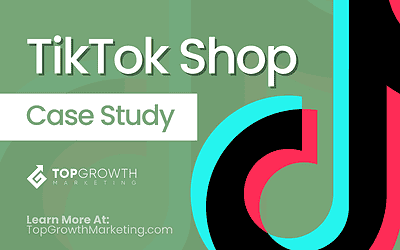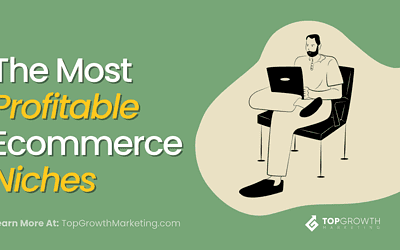If you’re a current or aspiring ecommerce merchant—you probably think about one thing.
Will online stores be profitable this year? The answer is a silent yes.
While profitability is possible, you must factor in intense competition, rising costs, and more frugal consumers.
As an ecommerce marketing agency—we have first-hand experience with the industry and it’s our task to achieve profitability for our clients.
So let’s talk about key factors that affect it—and get insights on navigating the landscape.
💸Want a complete guide to your eCom store’s profitability? Use our eCommerce audit tool to help see where you stand in relation to updated eCommerce benchmarks.
With just a few inputs, you can get instant insights into your store’s performance.
Is Ecommerce Profitable In 2025?
E-commerce can indeed be profitable. Put simply.
But will it be? That’s up to you. The biggest convenience of ecommerce is low overhead and lower initial investment—but the sheer competition can make you lose money quickly.
In fact, some well-known ecommerce brands took a while to become profitable.
For example, Allbirds—an eyewear brand operated at a loss for several years as it invested heavily in marketing and expanding its product offerings to build brand recognition and customer loyalty. Today they are seeing record profits.
Other brands like Rothy and Bonobos had the same fate before they eventually became a profitable brand. And a staple in the industry.
Here’s some things to know about eCom profitability in 2025.
What Are Ecommerce Profit Margins?
To know how profitable your store is, you should understand your margins.
E-commerce profit margins represent the percentage of revenue that remains as profit after all costs associated with running the business are deducted.
Here’s how you can calculate your gross profit margin:
A good gross profit margin for e-commerce is typically between 50% to 70%, with an average of around 41.54% reported by NYU Stern School of Business. That’s, of course, not that easy to achieve.
What are the Hidden Costs of Ecommerce?
We talk about profitability, but there are also hidden costs you may encounter along the way.
Let’s list them real quick:
- Return costs, like shipping fees for returns, restocking costs, and potential losses from damaged or unsellable items—can all be detrimental.
- Marketing costs can also escalate quickly, since attracting customers often requires significant investment in promotional strategies.
- Website maintenance and administration costs, as you’ll to invest in someone—or yourself—managing everything, paying monthly CMS fees, and similar.
- Inventory management costs, which involves costs related to storage, handling, and software solutions for tracking inventory levels.
- Taxes and duties that can vary by region or country.
…of course, there’s plenty more as you grow. Such as packaging costs, customer service expenses as you grow your store, various SaaS tools you’ll have to use, etc.
So take all that into account.
What Is the State of Ecommerce Profitability In 2025
The new year is upon us and the question looms—is it worth it to start an online store now?
Here are some stats that could paint a picture:
- There are currently between 12 million and 24 million online retailers globally. This number reflects steady growth in the eCommerce sector, with many new stores emerging alongside some closures as the market evolves. (Source)
- Global eCommerce sales are projected to reach approximately $6.8 trillion by 2028, with estimates suggesting that sales could surpass $7 trillion in 2024. (Source)
- The global eCommerce market is expected to grow at a compound annual growth rate (CAGR) of 8.9%, indicating robust expansion over the coming years. By 2027, eCommerce is projected to account for nearly 25% of total retail sales worldwide. (Source).
- While both online and offline shopping are prevalent, online shopping is increasingly dominating consumer behavior. As of now, about 20% of all retail sales occur online, and this figure is expected to rise. (Source).
But it’s not all roses and butterflies in ecommerce as well.
In a great report by Stacked Marketer, the numbers tell a different tale.
Namely, after the big pandemic boost, we’ve seen a surge of ecommerce stores. However, in 2023 and spilling into 2024, ecommerce growth definitely slowed down:
You’ve probably seen headlines of record-breaking Cyber Week sales, for instance, but what this report debunks is that there was any actual growth in ecommerce.
Adjusted for inflation, and the number of ecommerce stores that constantly rising—the ecommerce landscape is actually more competitive and a bigger risk today than it was.
Despite the numbers. And if you’re just starting, this could mean a lot of headaches.
Because while your ecommerce store can be profitlble, you’re in a ruthless, competitive industry that requires a lot of prep, knowledge—and ultimately luck—to succeed.
How to Know If Your Ecommerce Store Is Profitable?
Sometimes, knowing if your online store brings profit is simple.
You take revenue, deduct all the expenses—and voila! That’s your net profit.
But what happens when you aren’t sure? Or if your revenue fluctuates. Or you’re making sales, but somehow you still don’t make any profit.
To determine your store’s profitability, take note of the most important ecommerce KPIs such as gross margin, customer acquisition costs (CAC), lifetime value (LTV), and similar.
This will help you determine the metrics you need to improve so you can set up your strategy accordingly.
Another way to see the profitability of your store is by using a third-party tool.
We provide a completely free Ecommerce store Audit Calculator that will help you determine your store’s profitability across 52 metrics—as well as provide actionable tips to improve it.
Note: This is a pretty thorough calculator so make sure you have at least 15-20 minutes on your hands before diving into it.
Give it a shot.
How to Make Your Ecommerce Store More Profitable?
If your online store is not selling and you have a quality product and a set target audience—the problem might be in how you position it.
Bonus: You can find a bunch of tips on how to make ecommerce profitable in our CALCULATOR.
If you want to make your eCom store, focus on these key things:
Improve Brand Awareness
If you want to sell more products, focus on building a strong presence across social media—especially platforms like Instagram, Facebook, and TikTok.
You can do this organically—by just building a relationship with your customers, sharing uesr-generated-content, and posting frequently.
Of course, you can also pay for awareness—which we’ll talk about later, but you can also run giveaways to get your brand out there.
Moreover, share engaging content that showcases your products in real-life scenarios and leverage influencers or user-generated content to create trust with potential customers.
The more familiar people are with your brand, the more likely they are to buy.
“One overlooked tactic in brand-building is turning customers into co-creators. When buyers can personalize or customize what they purchase, they develop an emotional stake in your brand. That emotional investment is a powerful driver of brand loyalty and word-of-mouth marketing.”
Saulius Meilutis, CEO of print-on-demand platform Podbase
Optimize Conversion Rate
Optimizing your conversion rate increases your profitability by turning more of your site visitors into paying customers.
When you make the shopping experience smoother you help customers complete their purchases without hesitation. You can do this by:
- Reducing friction at checkout, making the process smoother
- Improving page load times
- Create clear product descriptions
It’s about getting the most value out of the traffic you already have, meaning even small tweaks can result in big revenue gains without needing to spend more on ads or traffic generation.
By converting more visitors, you boost sales without having to grow your marketing budget, making it one of the most cost-effective ways to increase profitability.
Invest In Paid Advertising
Paid ads can drive targeted traffic to your store. In other words, likely buyers.
For instance, platforms like Meta and Google can help you target the right audience based on their interests, behaviors, demographics, and more.
Paid ads also provide quick, measurable results, allowing you to scale up what’s working and stop what isn’t, optimizing your ad spend for maximum ROI.
By consistently bringing in qualified leads, you increase sales, which ultimately drives profitability. Plus, when paired with strategies like retargeting, you can recover lost sales from visitors who didn’t convert on their first visit.
This sounds easy, but the major downside of paid ads is that they are… well… paid. Meaning you’ll have to splash more cash on them.
And if you’re not profitable, investing becomes a big problem.
Optimize Your Store For Search Engines
Optimizing for search engines (or SEO) is a long-term strategy that can significantly increase help you drive high-quality, organic traffic to your ecommerce store.
And when your site ranks higher in search results, especially for relevant keywords, you attract more visitors who are actively looking for products like yours—making them more likely to convert.
Unlike paid ads, organic traffic doesn’t come with a cost per click, so the more visibility you gain, the higher your profit margins will be.
Plus, good SEO builds trust with customers since people often view top-ranking sites as more credible, which can lead to increased sales and customer loyalty over time.
Also, you can use this traffic to retarget website visitors or have people sign up to your brand’s newsletter—which can further boost acquisition or retention.
Don’t Neglect Retention
The best purchasers are past purchasers.
If you want to keep your ecommerce store profitable, you need to retain existing customers on top of acquiring new ones.
The best retention strategies include:
- Staying top-of-mind with your customers with strategies above
- Using email and sms marketing strategies to target past purchasers with new promotions, sales, upsells, and more.
- Implement a subscription model if possible.
- Offer loyalty programs and awards.
…and more.
Remember, it is much cheaper to sell to existing customers than to acquire new ones.
Loyal customers tend to make more frequent purchases and have higher average order value, which can boost your your overall revenue.
Additionally, retaining customers increases lifetime value, creating a steady revenue stream and more opportunities for upselling and cross-selling.
Increase Average Order Value
If your product is selling well, but you’re still not profitable—what can you do?
Try to up the value of your orders, for example. You can do this by strategically placing upsells and cross-sells throughout your store, bundling products, and offering bulk order discounts.
All this will make your customers inclined to spend more, increasing your average order value.
If you’re selling on Shopify, you can leverage many upsell and cross-sell apps to make your store click—and your AOV spike.
What Ecommerce Niches are Profitable
Ecommerce is a broad term.
So if we want to talk about ecommerce profitability, we might want to look at different “niches” that are profitable.
Especially thanks to the combination of their popularity, convenience, AOVs, retention, nad more.
Let’s check.
Pet Brands
Pet owners are emotionally invested in their pets.
Therefore, they are often willing to spend on high-quality food, accessories, and care products.
This niche also benefits from recurring purchases (e.g., food and treats) and growing trends like
premium pet care and personalized products.
We’ve been running ads for pet brands for years and can tell you—they always crush it.
Because pet brands aren’t only selling pet treats or toys, but also utilities that make lives easier for both pets and owners.
Apparel Brands
Apparel is a necessity. And online brands can profit by targeting specific styles, trends, or demographics (e.g., sustainable fashion, streetwear, or athleisure).
Fast-changing fashion trends and seasonality drive repeat purchases, while branding can create strong customer loyalty.
If you’re an apparel brand and are building on brand awareness, working with fashion influencers, and running ads email campaigns—there’s a big chance you’ll have a profitable brand.
Beauty and Health Brands
Shoppers worldwide are growing more focused on wellness and appearance, making beauty a high-demand niche.
Health and beauty products often have high margins, and recurring purchases (e.g., skincare, supplements) can lead to a loyal customer base.
This sector also thrives on influencer marketing and social media promotion.
Food and Beverage Brands
Food and beverage brands are profitable due to the recurring nature of consumable products, encouraging frequent repeat purchases.
They can build strong customer loyalty by focusing on taste, quality, or health benefits, which leads to consistent sales.
Additionally, specialty products like organic or niche items typically command higher margins as consumers are willing to pay more for premium offerings.
These brands also have significant growth potential by expanding into retail distribution and online channels, further scaling their reach and profitability.
Wholesale Brands
This could feel like a surprise inclusion, but in reality—wholesale brands are killing it when it comes to ecommerce. And there are a few reasons for that:
- Bulk Sales: Wholesale businesses sell in larger quantities, which increases total revenue per transaction.
- Consistent Demand: Wholesalers often establish long-term relationships with retailers or businesses, creating a steady stream of orders, resulting in reliable revenue.
- Lower Marketing Costs: Since wholesalers typically sell to other businesses rather than directly to consumers, they often require less investment in consumer-focused marketing, reducing customer acquisition costs.
- Higher Order Value: Wholesale transactions typically have a higher AOV, driving profitability even with lower profit margins on individual items.
Trust us. We’ve worked with wholesalers that made the jump from brick-and-mortar to ecommerce. They’ve never looked back.
Time to turn a profit
As we’ve seen, eCommerce profitability is achievable. And will be for a long time.
However, your success will depend on strategic planing and optimizing key metrics.
Focus on improving key performance indicators on your website and you can overcome challenges and build sustainable, profitable online store.
Don’t forget to check our ecommerce audit, which should help give you a few pointers as well.






0 Comments